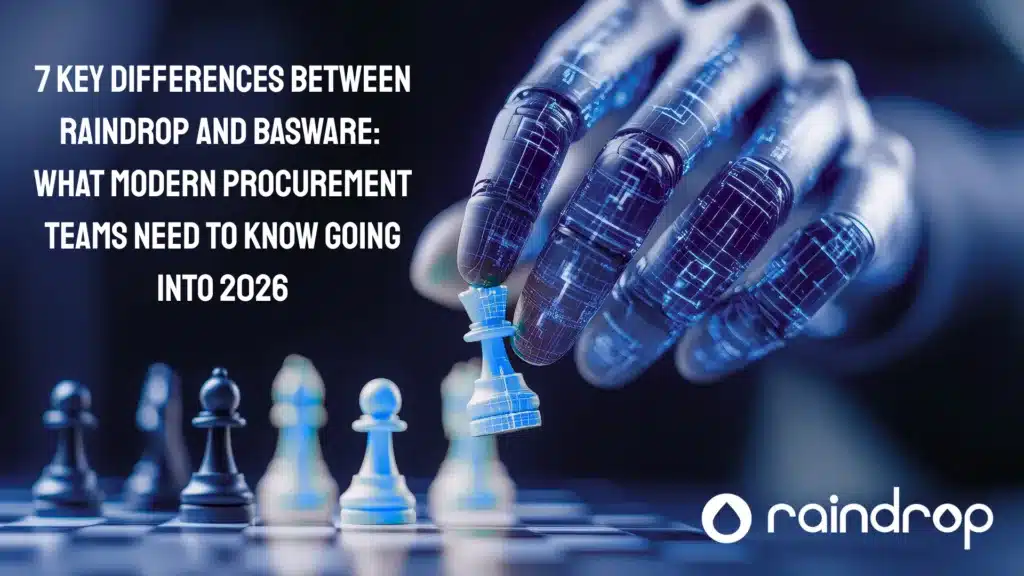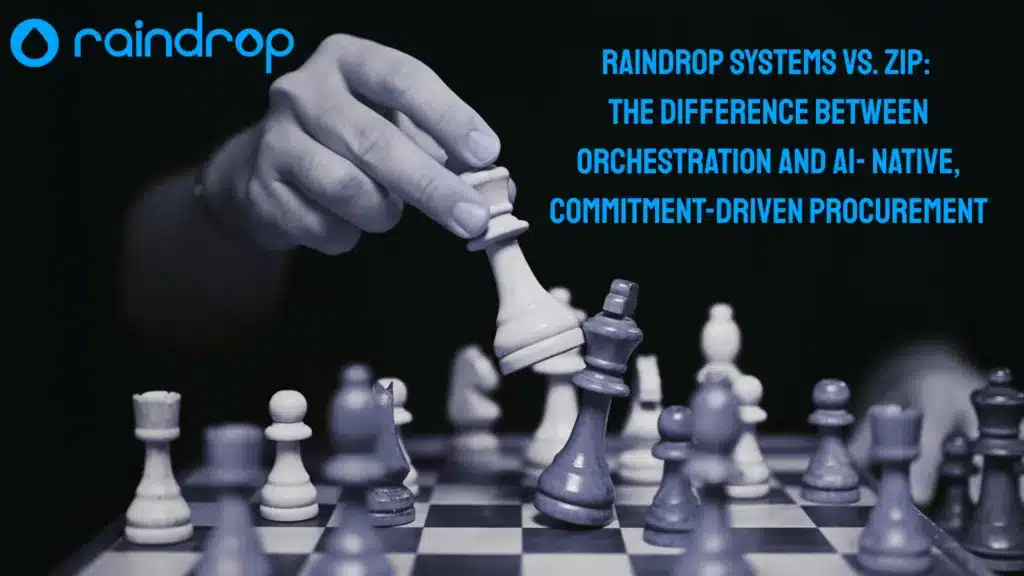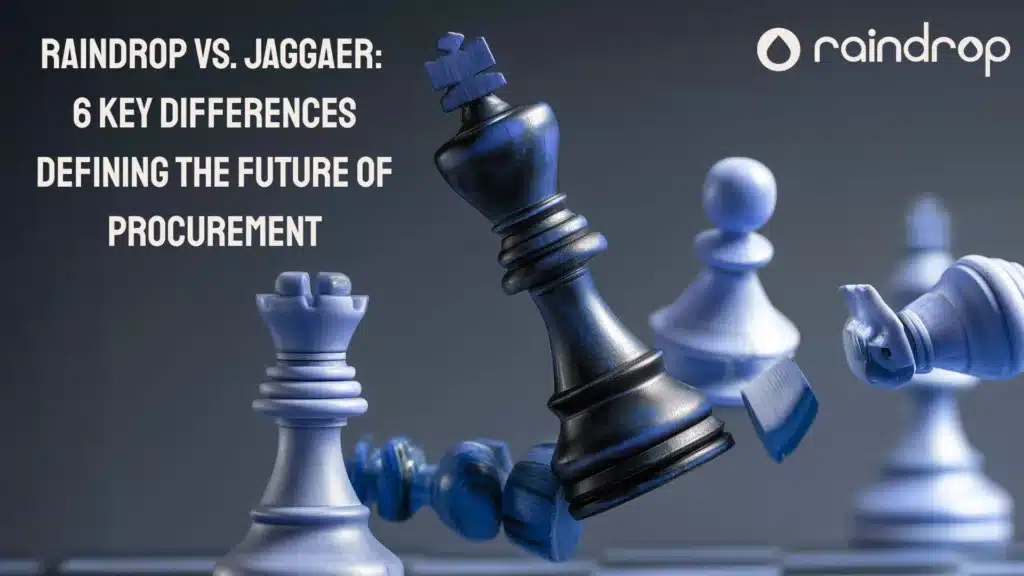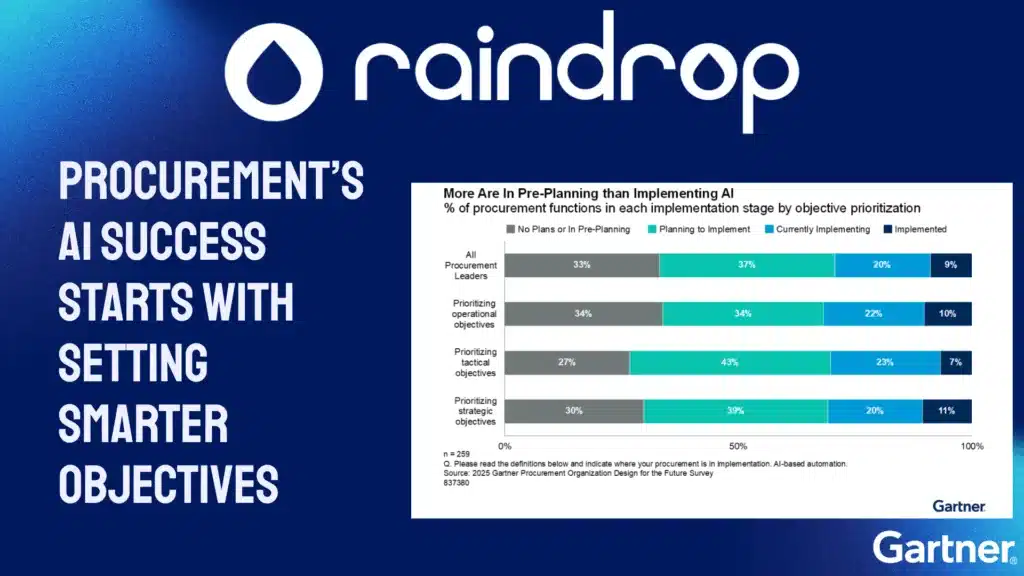Raindrop Systems vs SAP Ariba: 6 Key Differences—and a Clear Path to ROI
Key Takeaways
Faster time-to-value: Raindrop Systems implementations are measured in weeks with prebuilt connectors and configuration-first delivery—accelerating value capture without long change programs.
Lower TCO with AI-native workflow: Embedded AI drives automation and guidance across intake, sourcing, contracting, eProcurement, AP, and analytics—reducing manual effort and ongoing admin.
Fit for modern operating models: Configurable workflows, governed self-service, and zero-fee supplier collaboration keep adoption high across Procurement, Finance, and the business.
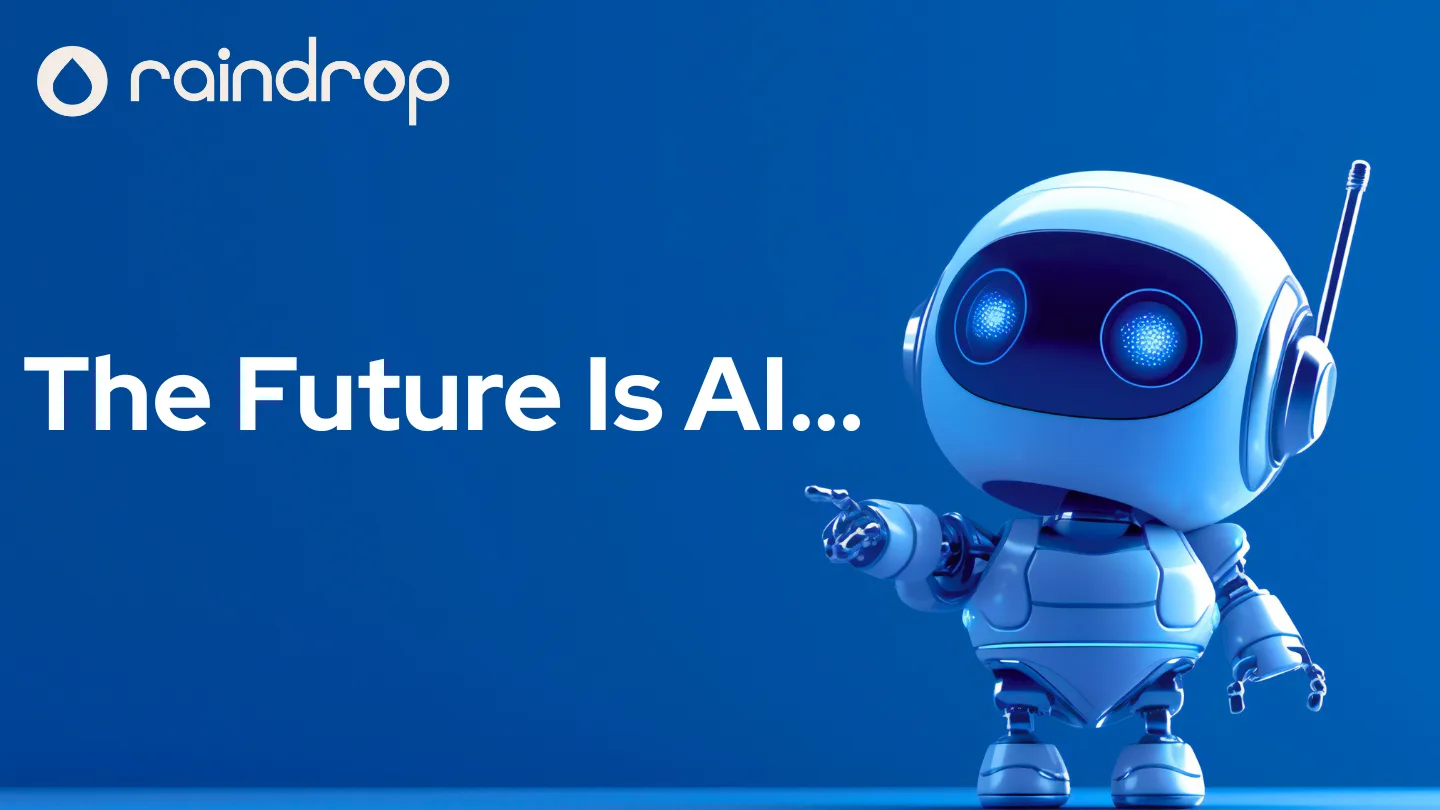


Introduction
SAP Ariba is a long-established name in Source-to-Pay (S2P). For many SAP-forward enterprises, it can be a logical choice. But as procurement priorities tilt toward agility, ease of use, and speed to measurable outcomes, organizations are testing alternatives that remove complexity while improving control.
Raindrop Systems is an AI‑native S2P platform designed for the modern operating model—workflows that start with intake orchestration, self-service guardrails, and analytics that surface action, not just dashboards. This comparison looks at where each platform fits and what to consider if you’re re-evaluating your S2P roadmap.
Platform at a Glance
Raindrop Systems
- AI‑native S2P platform spanning Intake Orchestration, Sourcing, Contract Lifecycle Management, eProcurement, AP Automation, and Analytics in one data model.
Explore modules: Intake Orchestration, Sourcing, Contract Lifecycle Management, eProcurement, AP Automation, Analytics. - Cloud-native, configuration-first architecture; integrates with SAP and non-SAP ERPs via Raindrop Integrations.
- Zero-fee supplier collaboration and guided experiences for requesters and approvers; see Supplier Management.
- AI‑native S2P platform spanning Intake Orchestration, Sourcing, Contract Lifecycle Management, eProcurement, AP Automation, and Analytics in one data model.
SAP Ariba
Broad suite across sourcing, contracts, and procurement; deep alignment with SAP ERP and ecosystem.
Long market tenure and global footprint.
Network-centric model with robust catalog and supplier connectivity.
Head-to-Head: 6 Key Differences
1. Usability & User Experience
- Ariba: Powerful but layered navigation and legacy paradigms can slow casual users and require training—particularly outside core procurement.
- Raindrop Systems: Consumer-grade UX with AI assistance embedded into every step—intake asks the right questions, forms auto-fill with policy context, and approvers get next-best actions inside their native workflow tools. See AI-Powered for the platform’s design approach.
Raindrop Systems Advantage: Guided actions, fewer clicks, and higher self-service adoption across business users while maintaining compliance.
2. Implementation Speed & Integration
-
Ariba: Programs often span quarters with multi-workstream change management—especially when tailoring to non-SAP landscapes.
-
Raindrop Systems: Configuration-first delivery, with prebuilt connectors and an integration layer designed to co-exist with multiple ERPs and finance systems (including SAP). Review Platform Overview and Integrations.
Raindrop Systems Advantage: Weeks to go-live for prioritized scopes; integration strategy meets you where you are.
3. Innovation & AI Depth
- Ariba: Incremental AI is being added across modules; innovation pace is influenced by SAP’s broader roadmap.
- Raindrop Systems: AI‑native. Generative and predictive capabilities power guided intake, supplier discovery and risk signals, automatic document authoring/summarization, anomaly detection, and proactive savings ideas—spanning S2P. Explore AI-Powered.
Raindrop Systems Advantage: Native AI reduces swivel-chair work and surfaces decisions earlier—shifting teams from reactive to predictive.
4. Flexibility & Scalability
- Ariba: Well-suited for highly standardized processes; customization can require external resources and longer release cycles.
- Raindrop Systems: Admins configure policies, forms, workflows, and dashboards without code. You can tune the level of governance per category, region, or spend type—supporting centralized, center-led, or federated models.
Raindrop Systems Advantage: Enterprise scale with agile reconfiguration as priorities change.
5. Collaboration & Supplier Engagement
- Ariba: Extensive network and catalog capabilities. Depending on commercial terms and geography, suppliers may encounter subscription and transaction-based fee models—buyer teams should validate fee structures with SAP and prepare change management for portal adoption.
- Raindrop Systems: Zero-fee supplier access, streamlined onboarding, and shared performance views minimize portal fatigue and speed adoption. See Supplier Management and our primer on Supplier Onboarding.
Raindrop Systems Advantage: Frictionless collaboration that strengthens supplier partnership without adding supplier costs.
6. ROI, Pricing & Total Cost of Ownership
- Ariba: Licensing and services reflect its enterprise footprint and breadth; payback depends on program scope, change management, and network participation.
- Raindrop Systems: Predictable pricing, lower administrative overhead, and measurable automation gains from AI-native workflows. For end-to-end ROI, see our Case Studies hub.
Raindrop Systems Advantage: Faster payback and lower TCO from a unified, AI-native platform
Security & Compliance
Both platforms target enterprise-grade requirements. Raindrop Systems supports single sign-on, granular role-based access, audit trails, and data governance controls aligned to enterprise policies. For industry-specific certifications and data residency options, engage our team to align with your compliance program.
Analyst & Customer Validation
-
IDC MarketScape recognized Raindrop Systems as a Leader in Source-to-Pay (2025). Read the announcement: Raindrop named a Leader in 2025 IDC MarketScape for S2P.
-
Spend Matters SolutionMap badges: multiple “Customer Favorite” recognitions across S2P, sourcing, spend analytics, supplier management, and more (Fall 2025). See our roundup articles starting here: S2P Customer Favorite.
-
Broader context on digital procurement outcomes: see research from The Hackett Group and perspective from Harvard Business Review
Comparison Table: Raindrop Systems vs SAP Ariba
| Evaluation Area | Raindrop Systems | SAP Ariba |
|---|---|---|
| Ease of Use | Guided intake, AI assistance, minimal training | Powerful but layered for casual users |
| Implementation Speed | Configuration-first; go-live in weeks for scoped rollouts | Multi-quarter programs, heavier change management |
| AI Depth | AI‑native across intake, sourcing, CLM, P2P, AP, analytics | AI added across modules; pace tied to broader SAP roadmap |
| Flexibility | No-code configuration; fits centralized or federated models | Strong standardization; customization can add complexity |
| Analytics & Insights | Unified data model; predictive and prescriptive insights | Mature reporting; cross-suite insights depend on deployment |
| Total Cost of Ownership | Predictable pricing; lower admin load | Enterprise-grade licensing and services |
Results You Can Measure
Organizations implementing Raindrop Systems typically target measurable outcomes across three horizons:
Cycle-time reduction: Guided intake, automated triage, and policy-aware routing reduce PR-to-PO and contract lead times.
Cost avoidance & savings acceleration: Category playbooks, supplier discovery, and event optimization compress sourcing timelines and improve competitive outcomes.
Process cost reduction: AI-driven document drafting, three-way match efficiency, and error prevention cut rework and touches across AP and CLM.
(Explore examples on our Case Studies page.)
Decision Framework: When Each Platform Fits
Choose SAP Ariba when:
You are deeply standardized on SAP ERP and want to maximize alignment with SAP’s roadmap.
Your operating model favors network-led procurement at global scale and you have the change capacity for multi-quarter programs.
Choose Raindrop Systems when:
You need speed to value—standing up intake, sourcing, or AP in weeks to move the needle this quarter.
You run a hybrid or multi-ERP environment and require flexible integration and data unification.
You want AI-native assistance that raises adoption without adding headcount or admin overhead.
Migration Plan: A Low-Risk Path from Ariba to Raindrop Systems
Scope & Value Mapping (Weeks 0–2): Prioritize 1–2 domains (e.g., Intake + Sourcing or AP Automation) with measurable KPIs.
Data & Integration Readiness (Weeks 1–4): Connect ERPs/HRIS/IDP; map master data and cost centers; set up SSO and RBAC. See Raindrop Integrations.
Configuration & Pilots (Weeks 3–8): Build policies, playbooks, workflows, and approval matrices; run pilots with representative categories.
Parallel Run & Change (Weeks 6–10): Migrate active pipelines and catalogs; provide guided in-app assistance; operate in parallel as needed.
Cutover & Hypercare (Weeks 10–12): Target clean data cutover, supplier enablement, and KPI validation; move to agile monthly releases.
SAP Ariba Alternatives (At-a-Glance)
| Alternative | Primary Strengths | Best Fit |
|---|---|---|
| Raindrop Systems | AI‑native S2P, rapid implementation, configurable workflows, unified analytics | Mid‑market to large enterprises needing agility and measurable ROI |
| Coupa | Mature P2P footprint, strong ecosystem | Enterprises investing in robust P2P standardization |
| JAGGAER | Broad global coverage, industry depth | Complex, global enterprises with specific vertical needs |
| GEP | Services + platform model | Organizations seeking solution plus consulting capacity |
| Zycus | Suite breadth, AI investments | Value-focused enterprises willing to tailor |
| Workday (Spend modules) | Native HR/Finance alignment | Workday ERP-centric organizations |
| Zip | Intake-first focus | Teams prioritizing lightweight intake with extensibility |
Bottom Line
SAP Ariba helped define digital procurement at enterprise scale. If your strategy is tightly coupled to SAP and you’re comfortable with multi-quarter programs, it can be the right path.
For procurement teams prioritizing agility, usability, and rapid ROI, Raindrop Systems offers a modern, AI‑native alternative—one data model, configurable workflows, and fast integration to your current stack.
See your potential in a 30‑minute value mapping with Raindrop Systems. Book a Demo.
FAQs
Is SAP Ariba part of SAP?
Yes. SAP Ariba is owned by SAP and integrates deeply with SAP ERP and SAP’s data model.
Is Raindrop Systems a full Source-to-Pay suite?
Yes. Raindrop Systems covers intake orchestration, sourcing, CLM, eProcurement, AP automation, and analytics in one platform. Start with Platform Overview.
How long does a typical Raindrop Systems implementation take?
Scoped rollouts are measured in weeks, with configuration-first delivery and prebuilt connectors.
Does Raindrop Systems integrate with SAP S/4HANA or ECC?
Yes. Raindrop Systems integrates with SAP and non‑SAP ERPs. Learn more: Raindrop Integrations.
How does supplier collaboration differ?
Raindrop Systems provides zero‑fee supplier access and simplified onboarding; SAP Ariba’s network model and fees depend on customer and supplier arrangements—buyers should confirm current terms with SAP.

